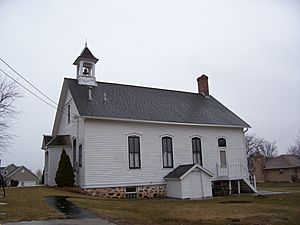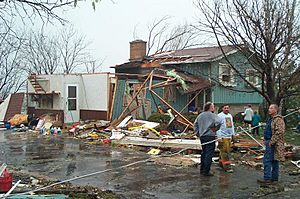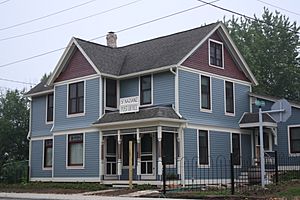St. Nazianz, Wisconsin facts for kids
St. Nazianz is a small village in Manitowoc County, Wisconsin, United States. It was founded in 1854. In 2010, about 783 people lived there.
Quick facts for kids
St. Nazianz, Wisconsin
|
|
|---|---|
|
Village
|
|
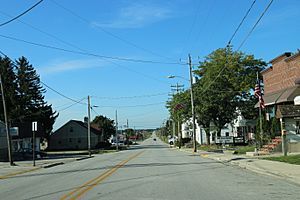
Looking north at downtown St. Nazianz in 2016
|
|
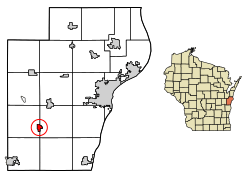
Where St. Nazianz is in Manitowoc County, Wisconsin
|
|
| Country | |
| State | |
| County | Manitowoc |
| Area | |
| • Total | 0.82 sq mi (2.11 km2) |
| • Land | 0.79 sq mi (2.06 km2) |
| • Water | 0.02 sq mi (0.06 km2) |
| Elevation | 856 ft (261 m) |
| Population
(2010)
|
|
| • Total | 783 |
| • Estimate
(2019)
|
750 |
| • Density | 944.58/sq mi (364.88/km2) |
| Time zone | UTC-6 (Central (CST)) |
| • Summer (DST) | UTC-5 (CDT) |
| ZIP code |
54232
|
| Area code(s) | 920 |
| FIPS code | 55-71025 |
| GNIS feature ID | 1573385 |
Contents
The Story of St. Nazianz
How the Village Started
St. Nazianz was created in 1854 as a special religious community. A group of German immigrants started it. They were led by Father Ambrose Oschwald, a Roman Catholic priest. The first 113 settlers came from the Black Forest area of Baden, Germany. They were looking for religious freedom in America.
Father Oschwald and his group sailed to America in 1854. Their journey took about 52 to 55 days. When they arrived in Milwaukee by train, some people in the group had sadly passed away. Father Oschwald bought about 3,840 acres (15.5 km²) of land in Manitowoc County. He paid $3.50 for each acre.
In August 1854, Father Oschwald sent six men to find the land he bought. They traveled by boat from Milwaukee to Manitowoc. Then, they went west by oxcart. They had to cut their way through a thick forest. On August 27, they reached their destination. The men named the place St. Nazianz. They chose this name to honor Gregory of Nazianzus.
Father Oschwald arrived on September 1 with more men. The group started clearing the land and building log houses. Soon after, they began building the community's first church. It was a 32-by-24-foot (9.8 by 7.3 m) building made by hand. By October 21, the church was half finished. Father Oschwald held the first Mass there.
The settlers called themselves "The Association." They decided to share everything and work without pay. This way of life continued until 1896. The group built shops and mills. The community grew and became successful within a few years. People learned many different jobs. These included blacksmithing, carpentry, masonry, and shoemaking. They also did woodworking, tailoring, barrel making, and rope making. Other jobs were tanning, weaving, brick-making, baking soda, and brewing.
Over the years, Father Oschwald helped start several religious groups. These included the Oschwald Brothers and the Franciscan Sisters of Christian Charity. Father Oschwald passed away on February 27, 1873. He was buried under the altar at the old St. Ambrose Church. Later, his body was moved to a special shrine near the Loreto Shrine Chapel in the village.
The Salvatorian priests and brothers came to St. Nazianz in 1896. They helped improve the community. They also built the St. Ambrose Church in 1898.
The Big Storm of 2000
Just before noon on May 12, 2000, a very strong storm hit St. Nazianz. It also affected nearby communities. The storm caused a lot of damage. At first, people thought it was a tornado. But later, experts said it was a "thunderstorm super cell moist microburst." This means it was a powerful downdraft of air. The winds were reported to be as fast as 120 miles per hour (190 km/h). The National Weather Service said wind gusts reached at least 75 miles per hour (121 km/h). People in St. Nazianz said it went from bright noon to dark night in just a few seconds.
The storm mostly followed U.S. Route 151. St. Nazianz and Chilton had the worst damage. This was mainly from strong winds and hail. The hail was as big as golf balls or even baseballs. Many houses were destroyed, and others were badly damaged. Many cars were ruined or needed a lot of repair from the hail.
The total damage from this storm in St. Nazianz and nearby areas was about $122 million. It was the first storm in Wisconsin to cause over $100 million in damage. Luckily, no one died in the storm. The village has since recovered well from the damage.
Village Location
St. Nazianz is located at coordinates 44°0′21″N 87°55′25″W.
According to the United States Census Bureau, the village covers a total area of about 0.85 square miles (2.2 km²). Most of this area, about 0.83 square miles (2.1 km²), is land. The rest, about 0.02 square miles (0.052 km²), is water.
You can reach St. Nazianz from I-43 (exit 144) by taking County Highway C. It is also accessible from WIS 42 and WIS 67 via County Highway C. To get there from U.S. 151, you can use County Highway A.
People Living in St. Nazianz
| Historical population | |||
|---|---|---|---|
| Census | Pop. | %± | |
| 1960 | 669 | — | |
| 1970 | 718 | 7.3% | |
| 1980 | 738 | 2.8% | |
| 1990 | 693 | −6.1% | |
| 2000 | 749 | 8.1% | |
| 2010 | 783 | 4.5% | |
| 2019 (est.) | 750 | −4.2% | |
| U.S. Decennial Census | |||
2010 Population Details
In 2010, there were 783 people living in the village. These people lived in 324 households, and 209 of these were families. The village had about 943 people per square mile (364.8 per km²). There were 346 housing units, with about 417 units per square mile (161 per km²).
Most of the people in the village were White (97.1%). A small number were Native American (0.1%), Asian (1.1%), or from other races (0.9%). About 0.8% of people were from two or more races. People who identified as Hispanic or Latino made up 1.7% of the population.
Out of the 324 households:
- 30.6% had children under 18 living with them.
- 49.7% were married couples living together.
- 9.0% had a female head of household with no husband present.
- 5.9% had a male head of household with no wife present.
- 35.5% were not families (individuals living alone or with non-relatives).
About 28.7% of all households were made up of individuals. Of these, 14.8% had someone living alone who was 65 years old or older. The average household had 2.42 people, and the average family had 2.97 people.
The average age of people in the village was 41.8 years.
- 22.7% of residents were under 18.
- 6.9% were between 18 and 24.
- 27.7% were between 25 and 44.
- 27.2% were between 45 and 64.
- 15.5% were 65 years or older.
The village had slightly more males (50.2%) than females (49.8%).
Famous People from St. Nazianz
- Joseph Filz: He was a Wisconsin State Representative and lived in St. Nazianz.
- Victor A. Miller: He was the Attorney General of Wisconsin and lived in St. Nazianz.
Images for kids
See also
 In Spanish: St. Nazianz (Wisconsin) para niños
In Spanish: St. Nazianz (Wisconsin) para niños


